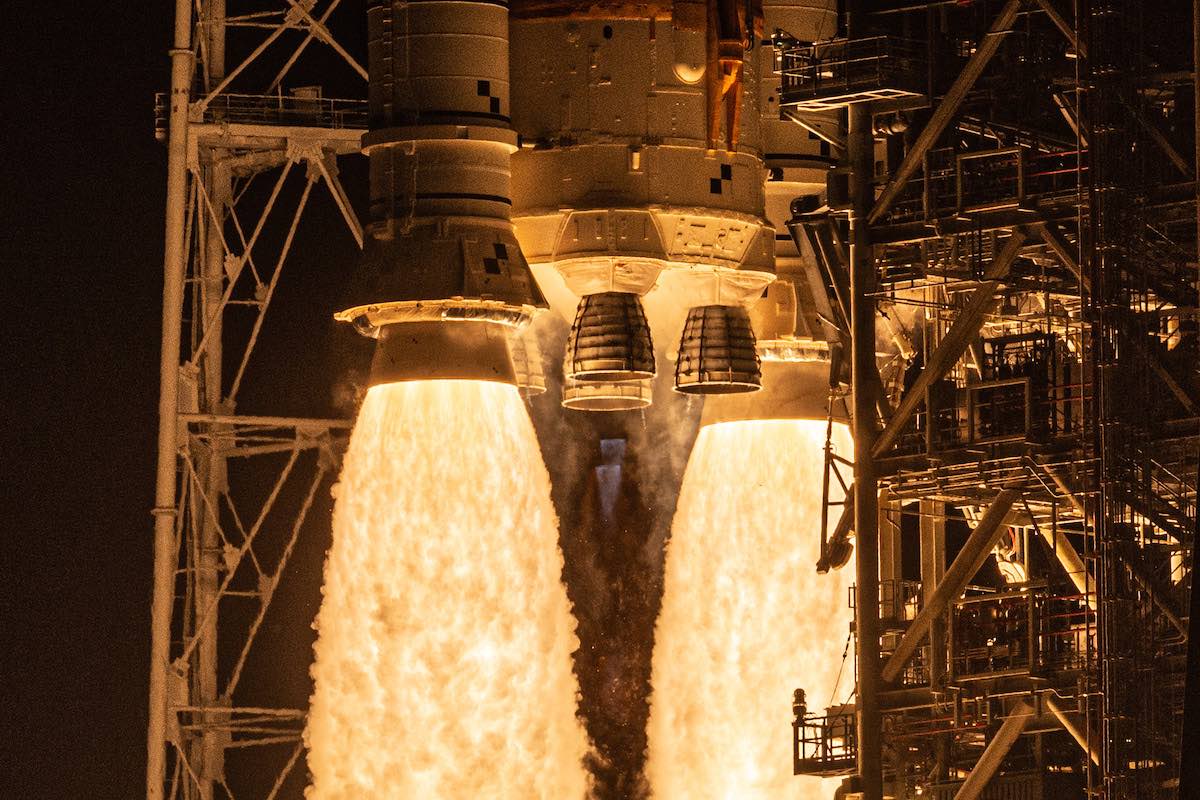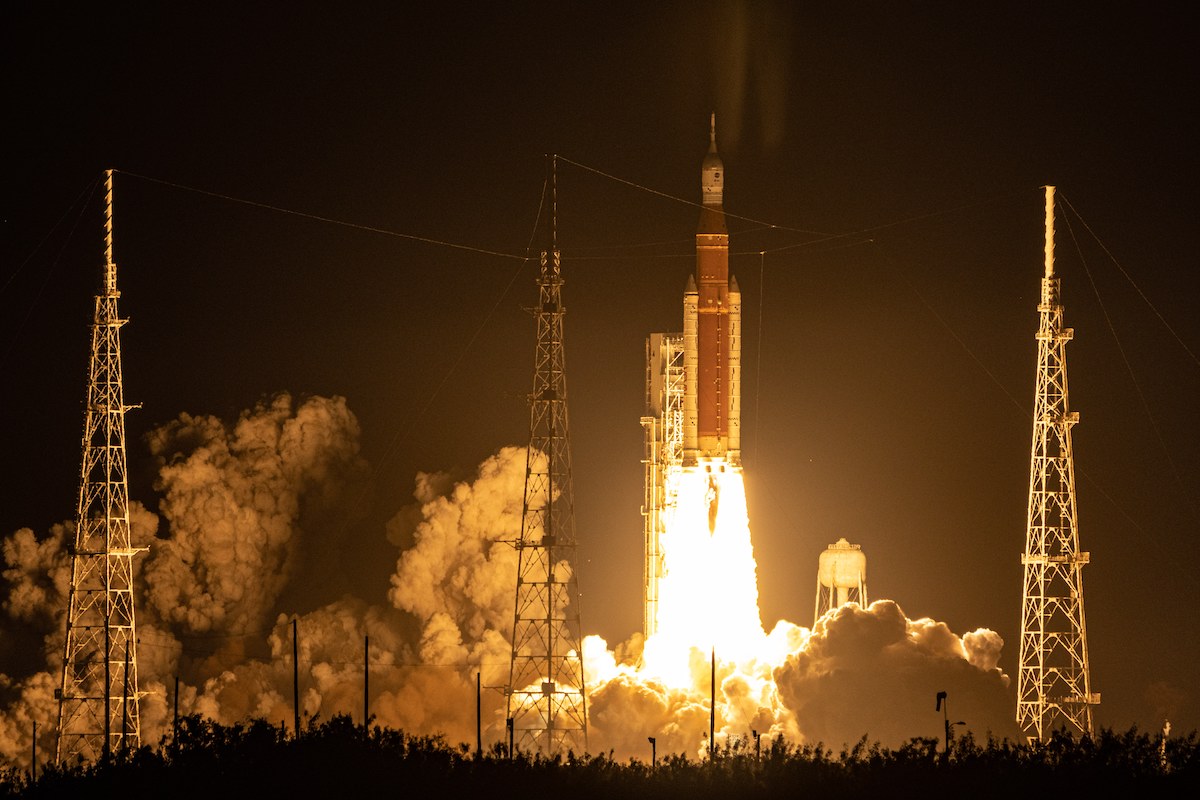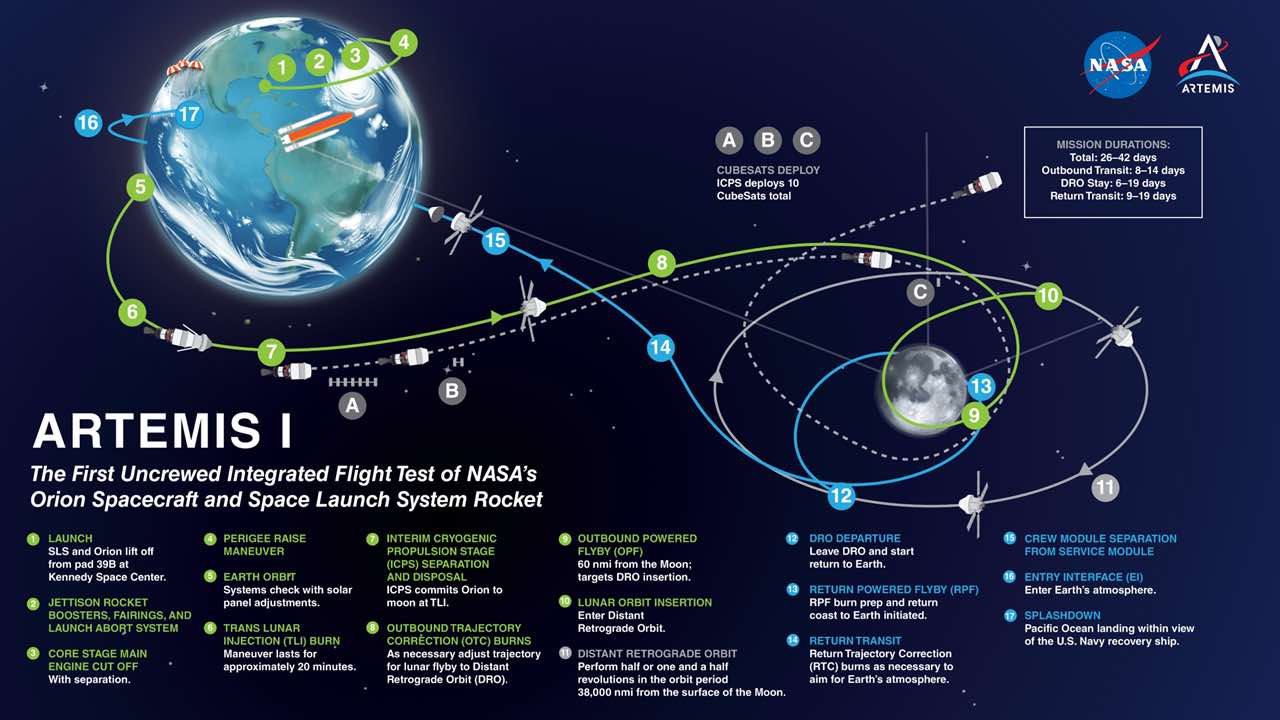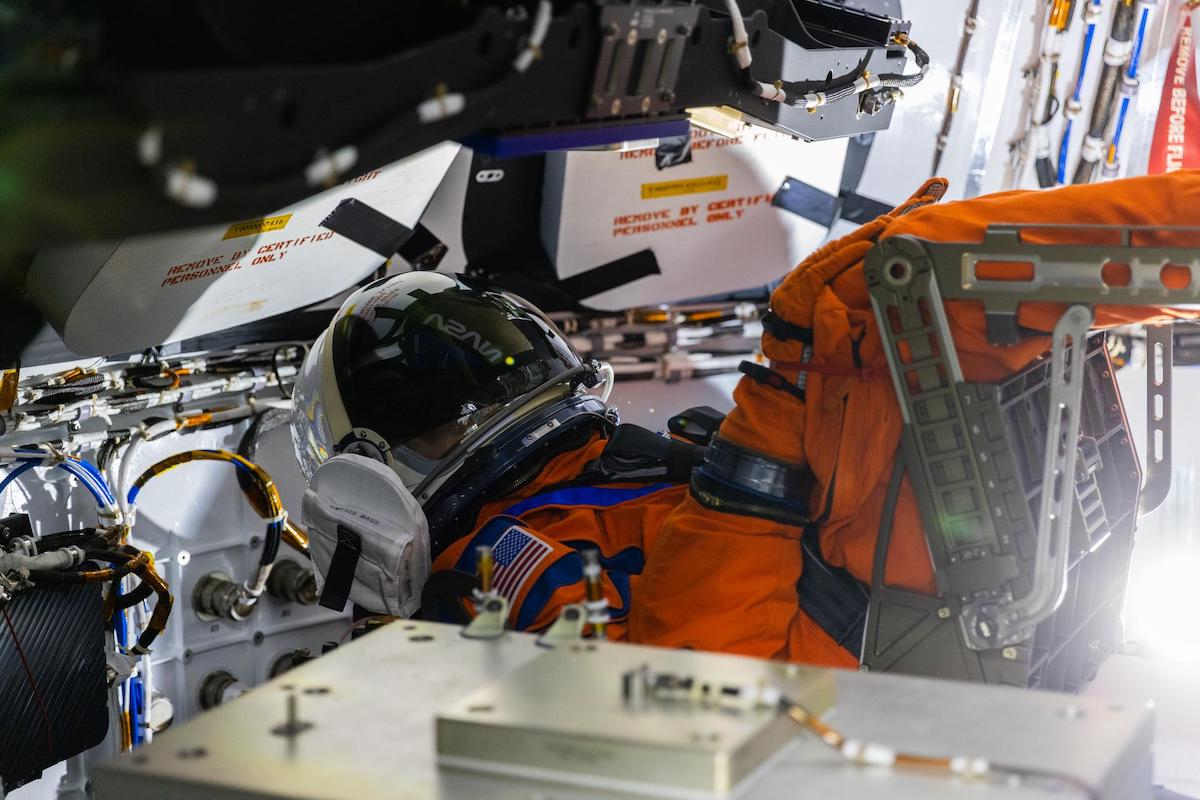
NASA’s huge Space Launch System moon rocket finally took off from Florida early Wednesday after a decade in development, sending an unpiloted Orion crew capsule toward lunar orbit on a 25-day test flight to lay a path for astronauts to return to the moon for the first time since 1972.
The launch from Kennedy Space Center marked the first major test flight for NASA’s Artemis program, a U.S.-led international effort to explore the moon with landers, rovers, orbiters, and a mini-space station that will serve as a staging base for lunar expeditions.
“I have to say, for what we saw tonight, it’s an A-plus,” said NASA Administrator Bill Nelson in a press conference after liftoff of the first SLS moon rocket. “It’s a test flight. It took a long time coming to get here. The last time we were on the moon was Apollo 17.”
Humans have not walked on the lunar surface since Gene Cernan and Harrison Schmitt departed the moon on the Apollo 17 mission, 50 years ago next month. NASA canceled the final Apollo moon missions, then focused on developing a reusable spacecraft that became the space shuttle. The agency’s human spaceflight program has been centered on the International Space Station, which flies in low Earth orbit, for the last two decades.
But NASA is setting up for humanity’s return to the moon, using the powerful Space Launch System rocket, Orion spacecraft, and an array of commercial partnerships and international agreements to supply landing craft, pressurized habitats, and elements for an outpost in lunar orbit called the Gateway.
The Artemis 1 mission that launched Wednesday is an end-to-end test of the SLS moon rocket and Orion capsule, which took off on a five-day outbound journey to the moon. Next week, the Orion spacecraft will swing into orbit around the moon for tests and checkouts, then return to Earth for splashdown in the Pacific Ocean on Dec. 11.
“We still have a long ways to go,” Nelson said. “This is just the test flight, and we are stressing it and testing it in ways that we will not do to a rocket that has a human crew on it. But that’s the purpose, to make it as safe as possible, as reliable as possible, for when our astronauts crawl on-board and go back to the moon.”
The launch phase of the Artemis 1 moon mission appeared to go off without a hitch, with a thundering blastoff from Kennedy Space Center’s pad 39B at 1:47:44 a.m. EST (0647:44 GMT).
The middle-of-the-night launch followed years of delays and cost overruns. The rocket’s most recent delays were caused by technical problems discovered during practice countdowns and launch attempts earlier this year. NASA engineers detected a significant hydrogen leak during a Sept. 3 launch attempt, then the mission suffered more schedule slips due to Hurricane Ian and Hurricane Nicole.
With good weather expected Wednesday morning, NASA loaded the SLS moon rocket with cryogenic propellants and counted down to a two-hour launch window. But another hydrogen leak signature required technicians to drive back to the launch pad late Tuesday night — with the rocket nearly full of flammable fuel — and tighten bolts to allow the countdown to proceed.
NASA launch director Charlie Blackwell-Thompson polled her team inside a firing room at Kennedy Space Center. After hearing a unanimous “go” for launch, she authorized the countdown clock to resume from a hold to tick down the final 10 minutes until liftoff.
The 322-foot-tall (98-meter) SLS moon rocket roared to life with ignition of four hydrogen-fueled RS-25 engines and two cylindrical solid rocket boosters — leftovers from the space shuttle program — mounted to each side of the voluminous orange core stage.

NASA kept the shuttle-era main engines in storage for nearly a decade, fitted them with new computers, and certified the liquid-fueled powerplants to fire at higher throttle settings for the SLS moon rocket. The solid-fueled motors were lengthened — with five segments instead of the four sections on the shuttle — to provide an extra boost.
The SLS rocket generated 8.8 million pounds of thrust at full power, more than NASA’s Saturn 5 moon rocket designed in the 1960s for the Apollo program. Only the Soviet Union’s N1 moon rocket, which failed on all four of its test flights from 1969 through 1972, produced more power at liftoff.
Now, for the first time since the Cold War-era U.S.-Soviet Space Race, there are two mega-rockets soon ready to enter service with NASA’s Space Launch System and SpaceX’s privately-developed Super Heavy and Starship launcher. The Super Heavy booster, designed for recovery and reuse, will generate nearly double the thrust of NASA’s SLS moon rocket with all of its 33 methane-fueled Raptor engines firing.
SpaceX is preparing for the first Super Heavy/Starship test launch from Texas into a low-altitude Earth orbit in the coming months, but the company has not set a firm schedule for the flight.
NASA’s SLS moon rocket is is a single-use design. That makes it significantly more expensive than SpaceX’s Starship, but the SLS design allows it to carry crew and cargo to the vicinity of the moon in a single shot. The Starship requires in-orbit refueling to reach the moon.
For Wednesday’s dazzling debut launch, Artemis 1 rocket veered east from Kennedy Space Center over the Atlantic Ocean. The two Northrop Grumman-built solid rocket boosters burned out and jettisoned about two minutes into the flight to call into the sea.
The rocket’s Boeing-made core stage continued burning its four Aerojet Rocketdyne RS-25 engines, combining to put out 2 million pounds of thrust on their own, for eight minutes. The engines chugged more than 700,000 gallons of super-cold liquid hydrogen and liquid oxygen propellants from the 27.6-foot-wide (8.4-meter) core stage tanks.
The main engines accelerated the rocket to near orbital velocity, then the core stage separated from upper part of the Space Launch System, an element produced by United Launch Alliance. The ULA-built piece of the rocket — called the Interim Cryogenic Propulsion Stage and based on a design for the Delta 4-Heavy rocket — fired its RL10 engine two times, initially to place the Orion spacecraft into a stable low Earth orbit, then to send the capsule toward the moon.
The final engine burn of the launch sequence, called the Trans-Lunar Injection, or TLI, accelerated the vehicle to a speed relative to Earth of more than 22,500 mph (36,300 kilometers per hour) and put the Orion spacecraft on a course to reach the moon Monday, Nov. 21.
More than 500 RL10 engines have flown on Atlas, Delta, and Titan rockets since 1963, but the RL10’s trans-lunar injection burn on the Artemis 1 launch was the longest-ever firing in space by the venerable engine type.
Miss this morning’s Artemis 1 launch? Here’s a replay of our live coverage of the first two minutes of the flight.
Liftoff from Kennedy Space Center occurred at 1:47:44am EST (0647:44 GMT).https://t.co/KKlPNQabsH pic.twitter.com/GpjiW6z1tn
— Spaceflight Now (@SpaceflightNow) November 16, 2022
The Orion capsule separated from the Space Launch System’s upper stage nearly two hours into the mission. At that point, without its no-longer-needed launch abort tower and aeroshell, the moon-bound spaceship had a mass of roughly 57,000 pounds (about 26 metric tons), around 1% of the 5.75-million pound total weight of the SLS moon rocket at liftoff.
Mike Sarafin, NASA’s Artemis 1 mission manager, said the moon rocket delivered the Orion spacecraft on a “dead-on” trajectory. “We’ve bought down a lot of risk today, but we’ve got a lot mission ahead of us,” Sarafin said.
If the Orion spacecraft has similar success on its round-trip flight to the moon and back, NASA aims to fly a crew of four astronauts around the moon in the second half of 2024 on the next Artemis mission.
That would be followed later this decade by a human landing near the moon’s south pole, and if NASA plans for the Artemis program come to fruition, a series of crewed and robotic lunar science missions that would open a new era in space exploration. NASA’s long-term goal is to land humans on Mars, but the moon missions will come first.
Artemis is the twin sister of Apollo in Greek mythology. One of the Artemis program’s chief objectives is to land the first woman and first person of color on the lunar surface.
The first Artemis test flight will validate the function NASA’s Orion spacecraft as it travels more than 40,000 miles beyond the far side of the moon before blazing back through Earth’s atmosphere at nearly 25,000 mph.
About eight hours after launch, the Orion spacecraft lit its main engine for the first time. The brief test-firing verified the engine, another leftover from the space shuttle program, was ready for a sequence of critical burns later in the Artemis 1 mission.
The Orion service module was funded by the European Space Agency and built by Airbus, with 33 engines and thrusters to control Orion’s orientation and adjust its course after launch. The service module’s main engine is a U.S. component — a refurbished space shuttle Orbital Maneuvering System engine that flew on 19 missions from 1984 through 2002.
The Orion capsule is on a course to swing about 80 miles (130 kilometers) over the lunar surface with its maneuvering engine firing Nov. 21. The outbound flyby five days after launch will guide the Orion spacecraft into a distant retrograde orbit with an average distance of more than 43,000 miles (70,000 kilometers) from the moon. At that distance from Earth, the spacecraft will be flying outside the magnetic field that shields the planet from solar and cosmic radiation.
Artemis 1 also carries a range of secondary payloads, including deployable subsatellites, or CubeSats, to pursue scientific and technology demonstration missions. There are experiments and payloads inside the Orion spacecraft, too. Three mannequins strapped into the crew module’s seats will help scientists gather data and test the performance of a new astronaut spacesuit and a vest to protect the human body against radiation.
Orion separation confirmed. The human-rated crew capsule is on the way to the moon after a seemingly picture-perfect launch on the maiden flight of NASA’s Space Launch System moon rocket. https://t.co/KKlPNQabsH pic.twitter.com/PVDtrsbzmK
— Spaceflight Now (@SpaceflightNow) November 16, 2022
Mission controllers at NASA’s Johnson Space Center in Houston are overseeing the Artemis 1 flight from launch though splashdown. They will exercise the Orion capsule’s guidance and navigation, propulsion and cooling systems, computers, software, and communications equipment. Some elements of Orion’s life support system, and its cockpit crew displays, are not on the Artemis 1 flight.
After a half-lap around the moon, the Orion spacecraft will aim for another close flyby of the moon to steer onto a path back to Earth.
The capsule will plunge into the atmosphere Dec. 11 using a “skip re-entry” technique to bleed off speed. The re-entry velocity is about 30 percent faster than a spacecraft returning from a mission to the International Space Station. The 25-day mission duration will exceed the 21-day design life of an Orion spacecraft on standalone mission. The Orion spacecraft can spend up to six months in space when docked to a space station.
Despite the abundant use of flight-proven hardware on the SLS moon rocket and Orion spacecraft, and extensive ground testing over the last decade, there were still unknowns going into the Artemis 1 mission. NASA assessed there is a 1-in-125 probability that the Orion spacecraft could be lost on the Artemis 1 mission. That’s more risk than the agency would accept on a mission with humans on-board.
On the Artemis 2 mission, the Space Launch System will initially place the Orion crew capsule into orbit around Earth, where the astronauts will perform checkouts, test out the ship’s rendezvous and docking systems, and then fire Orion’s service module engine to fly to the moon a quarter-million miles away.
The Artemis 2 mission will follow a “hybrid free return trajectory” around the moon. The Orion crew capsule won’t enter orbit around the moon, but still instead loop around the far side and return directly to Earth for splashdown in the Pacific Ocean.
The Orion spacecraft will arc out to a distance of 4,600 miles (7,400 kilometers) beyond the far side of the moon, farther than any humans have ever traveled into space.
The Artemis 2 mission will last around 10 days, paving the way for future landing expeditions and longer-duration flights to the Gateway, a mini-space staton NASA plans to construct in orbit around the moon.
The Artemis program’s first attempt to land a crew on the moon is penciled in for the Artemis 3 mission, scheduled for no earlier than 2025, with a derivative of the Starship vehicle SpaceX’s is developing in South Texas. The Orion spacecraft carrying astronauts from Earth with dock with the Starship lander near the moon to ferry the crew to the lunar south pole. The Starship will ascend back into space from the moon to link up with Orion to bring the astronauts back to Earth.

Future Artemis missions will utilize more commercially-developed lunar landing craft to deliver astronauts to the moon’s surface. NASA plans to debut a more powerful upper stage for the SLS moon rocket on the Artemis 4 mission, enabling assembly of the Gateway station in lunar orbit and hauling heavier cargo to the moon.
But Artemis 1 has to complete its mission before NASA can move forward with Artemis 2.
“The heat shield, the stressing of the system, the delivery and performance of SLS, and recovery of the vehicle are all critical things we need to do before we can talk about going to Artemis 2,” said Jim Free, NASA’s associate administrator for exploration systems development, the NASA division that manages the Artemis program. “If we don’t get all of those, we’ll have a discussion about the risk that remains before we would put crew onto Artemis 2.”
Suppliers and workers in all 50 U.S. states and 10 European countries contribute to the Artemis program, which has its roots in a revamp of NASA’s human space exploration plans at the beginning of the Obama administration. The Obama White House in 2010 canceled the behind-schedule Constellation moon program, which started development of the Orion spacecraft with a different launch system than the SLS.
While President Obama ordered NASA to focus on developing commercial human-rated capsules to transport astronauts to and from the International Space Station — resulting in the commercial crew program with SpaceX and Boeing as contractors — Congress directed the Obama administration and NASA to accelerate work on a huge government-managed rocket program called the Space Launch System.
The Obama administration proposed NASA use the SLS rocket and Orion spacecraft for a crew mission to an asteroid, proving technology for an eventual human flight to Mars. Under President Trump, the effort was re-targeted for the moon and renamed the Artemis program — the twin sister of Apollo in Greek mythology — with a goal of landing astronauts at the lunar south pole by the end of 2024.
NASA has given up on the 2024 deadline, and the 2025 timetable for the human moon landing is in doubt. But President Biden has kept the Artemis program alive, and NASA last year selected SpaceX to build the first human-rated moon lander in more than 50 years.
The Artemis program’s ultimate objective, according to NASA, remains to test technology and practice for eventual human expeditions to Mars.
But the Artemis missions come with a hefty price tag, and the SLS moon rocket’s first flight Wednesday occurred five years later than NASA officials originally predicted.
NASA’s inspector general reported each of the first four Artemis missions will cost $4.1 billion apiece. None of the SLS moon rocket is reused, despite engines and boosters originally designed for multiple launches. NASA and Lockheed Martin eventually plan to refurbish and reuse Orion crew modules.
The agency watchdog also projected NASA will have spent $93 billion on the Artemis moon program by the end of 2025, including expenses for the SLS moon rocket, Orion spacecraft, ground systems, a human-rated moon lander, and the Gateway station.

So far, NASA has spent more than $48 billion to develop the Space Launch System, Orion spacecraft, and prepare ground systems at the Kennedy Space Center for the new-generation moon program.
NASA committed $14.2 billion to develop the Orion spacecraft from 2012 through the end of the last fiscal year Sept. 30, plus an additional $6.3 billion committed to the program in the prior decade under the Constellation program.
NASA budgeted $22.4 billion for the SLS program from 2012 through the end of fiscal year 2022. Another $5.4 billion in the same period went toward readying Kennedy Space Center’s ground infrastructure for SLS and Orion missions.
Email the author.
Follow Stephen Clark on Twitter: @StephenClark1.
